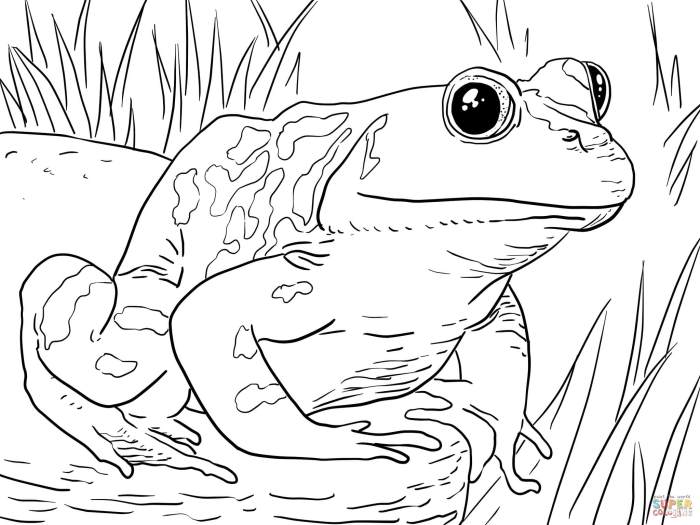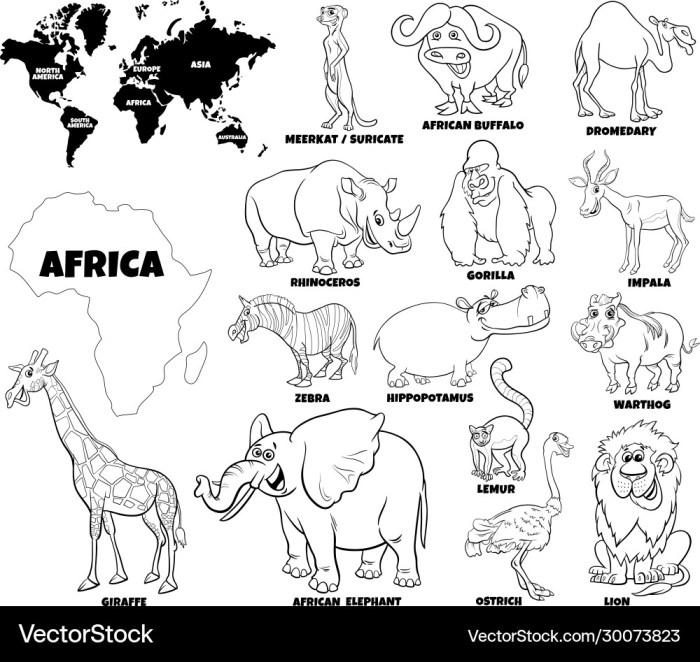Target Audience Identification
Printable coloring book animals – Creating a successful printable animal coloring book requires a deep understanding of its target audience. This involves identifying not only the children who will be coloring but also the parents or caregivers who will be making the purchasing decisions. By understanding their needs and preferences, we can create a product that resonates with both groups and achieves maximum market penetration.This analysis will delve into the age ranges most likely to engage with an animal coloring book, the characteristics of those who purchase them, and the specific interests and preferences of children within those age groups.
This granular understanding will inform design choices, content selection, and marketing strategies.
Age Ranges
The primary age range for printable animal coloring books spans from preschoolers (ages 3-5) to early elementary school children (ages 6-8). Preschoolers are drawn to simple, bold designs and easily recognizable animals, while older children may appreciate more intricate details and potentially themed pages, such as a jungle scene or an underwater adventure. While older children (9-12) might still enjoy coloring, their interests may shift towards more complex activities, making a dedicated coloring book less appealing.
Therefore, focusing on the 3-8 year-old demographic maximizes the potential market.
Yo, check out these totally awesome printable coloring book animals! They’re like, super cute and perfect for unleashing your inner artist. If you’re looking for even more options, hit up free coloring pages animal for a massive selection. Then, once you’ve found your faves, print ’em out and get coloring – it’s the ultimate chill vibe!
Parent/Caregiver Characteristics
Parents and caregivers who purchase or download printable animal coloring books often value several key characteristics. They typically prioritize affordability, convenience, and educational value. Many seek activities that encourage creativity, fine motor skill development, and quiet time for their children. Parents may also be influenced by factors such as the book’s design aesthetic, the variety of animals depicted, and the overall quality of the printable pages.
For example, a parent might choose a book with high-resolution images to ensure crisp, clear prints, and they may prefer themes aligned with their child’s current interests, such as dinosaurs or farm animals. They are also likely to appreciate eco-friendly options or those that promote learning, such as books that incorporate facts about the animals depicted.
Children’s Interests and Preferences
Children’s preferences vary significantly depending on age. Preschoolers are generally captivated by bright colors, simple shapes, and familiar animals like cats, dogs, and farm animals. They may enjoy repetitive patterns and large coloring areas. Older children (6-8) often prefer more detailed images, a wider variety of animals (perhaps including more exotic creatures), and possibly themed pages that tell a story or create a scene.
They may also show an interest in specific animal groups, like dinosaurs, ocean creatures, or mythical beasts. For example, a book featuring a vibrant underwater scene with various fish and coral would likely appeal to a child fascinated by the ocean, while a book filled with detailed dinosaur illustrations would resonate with a child who loves paleontology.
Animal Selection and Design

Creating a compelling coloring book hinges on thoughtful animal selection and engaging design. The animals chosen should resonate with the target audience, offering a balance of familiarity and visual interest. The design style, in turn, should complement the animals and enhance the overall coloring experience. This section will detail the process of selecting appropriate animals and developing a visually appealing style for the coloring pages.
Careful consideration of both animal choice and design style is crucial for a successful coloring book. The right combination will captivate your target audience and encourage creative expression. This includes choosing animals that are visually appealing, age-appropriate, and culturally relevant. The design style will further influence the overall aesthetic and user experience.
Animal Selection by Age Appropriateness
The complexity of the animal illustrations should directly correlate with the age group. Simpler designs are ideal for toddlers, while older children will appreciate more intricate details. This ensures that the coloring experience remains engaging and appropriately challenging for each age range.
- Toddlers (Ages 2-4): Elephant, Giraffe, Dog, Cat, Butterfly, Ladybug, Sun, Moon, Star, Simple Shapes (circle, square, triangle).
- Preschoolers (Ages 4-6): Bear, Pig, Monkey, Rabbit, Owl, Fish, Simple Farm Animals (Cow, Sheep, Chicken), Slightly more complex shapes.
- Older Children (Ages 7-12): Panda, Tiger, Lion, Zebra, Horse, Whale, Dolphin, Birds of Prey (Eagle, Owl), More detailed animals with intricate patterns.
Panda Bear Illustration Design
A simple, cute panda bear is a perfect addition to a coloring book. The design below emphasizes key features while remaining accessible to a wide age range.
Line Weight: Varying line weights add depth and visual interest. Use thicker lines for Artikels and thinner lines for details like fur texture or facial features. A consistent, medium weight is suitable for most lines. Thicker lines will help prevent younger children from going outside the lines.
Color Palette Suggestions: Classic black and white, with the option to add touches of grey, light brown, or blush pink for shading or accents. This classic palette is familiar and leaves plenty of creative space for the child.
Key Features to Emphasize: Large, expressive eyes; a round, fluffy body; distinct black patches around the eyes and ears; a slightly clumsy posture. These details enhance the overall cuteness and appeal. Consider adding simple bamboo stalks for context. The illustration should be simple and uncluttered, avoiding too much detail.
Imagine a round, slightly plump panda sitting upright. Its large, dark eyes are wide and friendly, framed by distinctive black patches that extend down its cheeks. The ears are round and slightly tilted, adding to its charming appearance. The body is covered in simple, soft curves to suggest fur. The panda’s paws are small and round, with simple, stubby claws.
A few simple bamboo stalks add context and complete the scene.
Visual Style for the Coloring Book
The choice of visual style significantly impacts the overall aesthetic and appeal of the coloring book. A consistent style enhances the visual cohesion and creates a memorable experience.
- Realistic Style: Detailed and accurate representations of animals, focusing on anatomical correctness and natural textures. This style is better suited for older children.
- Cartoonish Style: Exaggerated features, simplified shapes, and bright colors. This style is widely appealing and suitable for all age groups. Think of the classic Disney animal style.
- Minimalist Style: Simple lines, limited details, and a focus on basic shapes. This style is particularly effective for younger children and emphasizes the coloring process itself.
- Line Art Styles Examples:
- Bold Artikels with minimal interior detail: This creates a clean and modern look.
- Fine lines with intricate hatching and cross-hatching: This adds texture and depth to the illustrations.
- Thick, playful lines with rounded shapes: This produces a fun and child-friendly aesthetic.
- Geometric shapes used to build animal forms: This creates a unique and stylized look.
Page Layout and Design: Printable Coloring Book Animals

Creating visually appealing and engaging coloring book pages requires careful consideration of layout and design elements. The goal is to provide ample space for coloring while also incorporating visually stimulating design choices that enhance the overall user experience. This involves strategic placement of illustrations, borders, and other design elements to create a balanced and harmonious page.Effective page layout is crucial for a successful coloring book.
It ensures that the illustrations are the focal point, while complementary elements enhance the overall aesthetic appeal without distracting from the core activity of coloring. Careful consideration of negative space and visual balance is key to achieving this.
Sample Page Layout
A well-designed coloring book page strikes a balance between the illustration and the surrounding elements. Consider this example using a simple two-column layout represented with an HTML table:
|
Column 1: Illustration |
Column 2: Border and Text |
Full-Page Spread Design
A two-page spread offers the opportunity to create a more complex and visually interesting design. Consider a spread featuring a lion on one page and a giraffe on the other. The lion, a larger illustration, occupies approximately 60% of its page, positioned slightly off-center to the right, creating visual interest and utilizing negative space effectively. The remaining space is left largely blank, except for a subtle, repeating pattern of small paw prints in the lower left corner.
The giraffe, a smaller illustration, occupies about 40% of its page, placed slightly off-center to the left. It is accompanied by a simple, decorative border that mirrors the paw print pattern on the opposite page, subtly linking the two illustrations. This creates a sense of visual balance and cohesion across the spread.
Animal Illustration Arrangement Across a Two-Page Spread, Printable coloring book animals
The following table demonstrates how different animal illustrations can be arranged across a two-page spread (four columns). This arrangement prioritizes visual balance and prevents overwhelming the reader with too many details on a single page.
| Page 1, Column 1 | Page 1, Column 2 | Page 2, Column 1 | Page 2, Column 2 |
|---|---|---|---|
| Large illustration of an elephant, filling most of the column. | Smaller illustration of a bird, positioned to the right. | Smaller illustration of a fox, positioned to the left. | Large illustration of a bear, filling most of the column. |
